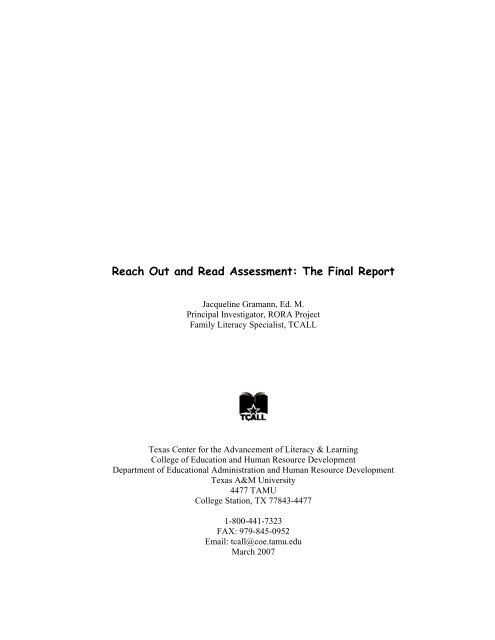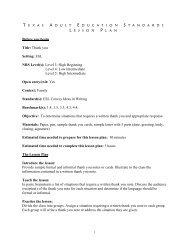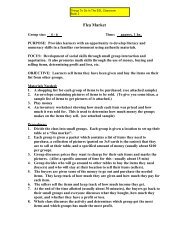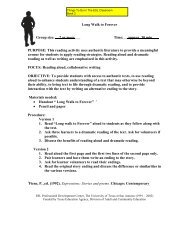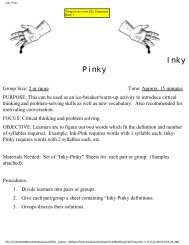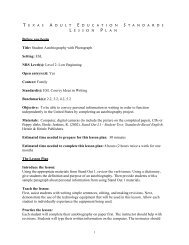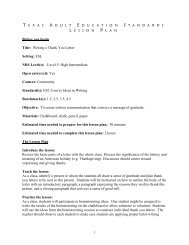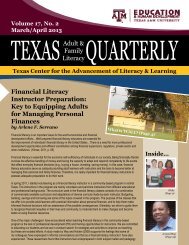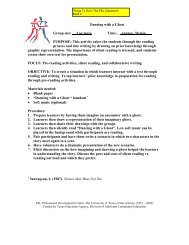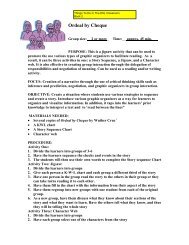Reach Out and Read Assessment: The Final Report - Texas Center ...
Reach Out and Read Assessment: The Final Report - Texas Center ...
Reach Out and Read Assessment: The Final Report - Texas Center ...
You also want an ePaper? Increase the reach of your titles
YUMPU automatically turns print PDFs into web optimized ePapers that Google loves.
<strong>Reach</strong> <strong>Out</strong> <strong>and</strong> <strong>Read</strong> <strong>Assessment</strong>: <strong>The</strong> <strong>Final</strong> <strong>Report</strong>Jacqueline Gramann, Ed. M.Principal Investigator, RORA ProjectFamily Literacy Specialist, TCALL<strong>Texas</strong> <strong>Center</strong> for the Advancement of Literacy & LearningCollege of Education <strong>and</strong> Human Resource DevelopmentDepartment of Educational Administration <strong>and</strong> Human Resource Development<strong>Texas</strong> A&M University4477 TAMUCollege Station, TX 77843-44771-800-441-7323FAX: 979-845-0952Email: tcall@coe.tamu.eduMarch 2007
TABLE OF CONTENTS:IntroductionBackgroundMethodData Collection: RORA Parent SurveyData Collection: PLS-4—Child <strong>Assessment</strong><strong>The</strong> SampleInterview ProcessFindingsData Analysis: <strong>The</strong> Parent Survey<strong>The</strong> Follow-up VisitData Analysis: <strong>The</strong> Child <strong>Assessment</strong>ConclusionAssumptions <strong>and</strong> LimitationsNext StepsBest Practices in Family LiteracyReferences <strong>and</strong> ResourcesAppendixParent Responses from the ROR site about their <strong>Reach</strong> <strong>Out</strong> <strong>and</strong> <strong>Read</strong> experienceRORA Parent SurveyData SummaryFamily Literacy—Short Survey (FL-SS)<strong>Reach</strong> <strong>Out</strong> <strong>and</strong> <strong>Read</strong> <strong>Assessment</strong>: <strong>The</strong> <strong>Final</strong> <strong>Report</strong>2
Introduction<strong>Reach</strong> <strong>Out</strong> <strong>and</strong> <strong>Read</strong> (ROR) is a national family literacy program. A local ROR requested an evaluationof their program to validate the program for its stakeholders. <strong>The</strong> main objective was to answer thequestion: is the program evidence-based?<strong>The</strong> <strong>Reach</strong> <strong>Out</strong> <strong>and</strong> <strong>Read</strong> <strong>Assessment</strong> (RORA) project evaluated the local ROR program with an oral(bilingual) survey <strong>and</strong> a child assessment using the PLS-4: Preschool Language Scale, Fourth Edition(Zimmerman, 2002) instrument. A sample of families was asked to participate at their child’s six montholdwell-baby visit with a follow-up at the 12-month well-child visit. Impact of the local ROR program onthe families was measured against a control population as well.<strong>The</strong> purpose of the quasi-experimental study was to evaluate the effectiveness of the local ROR program<strong>and</strong> to provide feedback to the program, the volunteers, the medical community, <strong>and</strong> the researchcommunity. Previous research done with a similar questionnaire had shown positive results for the earlyliteracy intervention (ROR, 2001; ROR, 2003-2006). Could the survey findings be replicated with a smallsample? Can an assessment of the children show positive results with the youngest age group in a RORprogram? <strong>The</strong> project expected to add to the growing research base which is showing that early literacyinterventions have a positive impact on children.An objective of early literacy interventions is to increase the school readiness abilities of young childrenat an age when parent input is significant (National Scientific Council on the Developing Child, 2004;Dickinson, 2006). Literacy abilities at kindergarten have been shown to be related with reading abilities inthe later elementary years (National <strong>Center</strong> for Family Literacy, 2005; Dickinson, 2006).In the past 20 years, early literacy has become a frequent message directed toward parents in our society.ROR <strong>and</strong> other family literacy programs empower young parents by helping families to underst<strong>and</strong> theconnection between activities when the child is six months of age <strong>and</strong> learning to read during the schoolyears. Shared book reading has been shown to enhance language, not the early literacy skills directly.Increasing a child’s vocabulary before learning to read can impact phonological awareness <strong>and</strong> listeningcomprehension. Learning vocabulary indirectly assists in learning to read (Dickinson, 2006). <strong>The</strong>National Early Literacy Panel has compiled a synthesis of early literacy research (National <strong>Center</strong> forFamily Literacy, 2005).Background“<strong>Reach</strong> <strong>Out</strong> <strong>and</strong> <strong>Read</strong> is a national non-profit organization that promotes early literacy by giving newbooks to children <strong>and</strong> advice to parents about the importance of reading aloud in pediatric exam rooms<strong>Reach</strong> <strong>Out</strong> <strong>and</strong> <strong>Read</strong> <strong>Assessment</strong>: <strong>The</strong> <strong>Final</strong> <strong>Report</strong>3
across the nation (ROR, 2003-2006).” <strong>The</strong> ROR model includes that “physicians <strong>and</strong> nurses adviseparents that reading aloud is the most important thing they can do to help their children love books <strong>and</strong> tostart school ready to learn (ROR, 2003-2006).”THE REACH OUT AND READ MODEL (ROR, 2003-2006)PEDIATRICIANS AND OTHER CLINICIANS ARE TRAINED IN THE THREE PART ROR MODEL IN AN EFFORT TOPROMOTE PEDIATRIC LITERACY:1. AT EVERY WELL-CHILD CHECK-UP, DOCTORS AND NURSES ENCOURAGE PARENTS TO READ ALOUD TOTHEIR YOUNG CHILDREN, AND OFFER AGE-APPROPRIATE TIPS AND ENCOURAGEMENT. PARENTS WHOMAY HAVE DIFFICULTY READING ARE ENCOURAGED TO INVENT THEIR OWN STORIES TO GO WITH PICTUREBOOKS AND SPEND TIME NAMING OBJECTS WITH THEIR CHILDREN.2. PROVIDERS GIVE EVERY CHILD BETWEEN THE AGES OF SIX MONTHS AND FIVE YEARS A NEW,DEVELOPMENTALLY APPROPRIATE CHILDREN'S BOOK TO KEEP.3. IN LITERACY RICH WAITING ROOM ENVIRONMENTS, OFTEN WITH VOLUNTEER READERS, PARENTS ANDCHILDREN LEARN ABOUT THE PLEASURES AND TECHNIQUES OF LOOKING AT BOOKS TOGETHER<strong>The</strong> local <strong>Reach</strong> <strong>Out</strong> <strong>and</strong> <strong>Read</strong> program uses the ROR model, with slight modifications. Physiciansreported that a typical well-child visit, between six months <strong>and</strong> five years of age, consists of the doctorintroducing a book at the end of the visit, so it is the last thing that the parents hear, <strong>and</strong> modeling how toread the book with developmentally appropriate suggestions. For example, at six months, 1-2pictures/pages are read to the child; at 12 months, 3-6 pictures/pages are read. Advice to parents begins atsix months with the suggestion of reading 2-3 minutes, 3-4 times a day. <strong>The</strong> reading of sounds <strong>and</strong>naming of objects in the pictures is suggested <strong>and</strong> modeled. As the child grows older, the suggestedamount of time spent in a reading session increases, with age-appropriate interactions between the parent<strong>and</strong> child being modeled. For example, at 12 months, modeling includes pointing <strong>and</strong> naming of theobjects in the pictures, as well as asking questions, <strong>and</strong> taking the child’s finger to point at the pictures.<strong>The</strong> doctor models in Spanish language, if Spanish is the primary home language. <strong>The</strong>n, the doctor givesthe book to the child. Some ROR programs write a prescription for the parent to read to the child. ThisROR chooses to reduce the paperwork the parent has to deal with. <strong>The</strong> principle difference from the RORmodel is that the study ROR models book reading at the end of the visit.<strong>The</strong> <strong>Reach</strong> <strong>Out</strong> <strong>and</strong> <strong>Read</strong> <strong>Assessment</strong> (RORA) project was initiated in 2004 at the request of the RORCoordinator for the new, local program. In September, the <strong>Texas</strong> A&M University Institutional ReviewBoard – Human Subjects in Research approved the protocol.Because of the need to hire a bilingual assistant, the project did not begin until July of 2005 at the ROR(treatment) site. In short order, final approval at a control site was secured <strong>and</strong> the study began at thecontrol site within a week of completing 22 families at the ROR site. <strong>The</strong> control site was completed inOctober of 2005 with 20 families participating. <strong>The</strong> follow-up with the 42 families was planned for sixmonths later.<strong>Reach</strong> <strong>Out</strong> <strong>and</strong> <strong>Read</strong> <strong>Assessment</strong>: <strong>The</strong> <strong>Final</strong> <strong>Report</strong>4
Figure 1: ROR READING CORNERPhoto by J. GramannMethod<strong>The</strong> survey <strong>and</strong> assessment sites consisted of the experimental site, or <strong>Reach</strong> <strong>Out</strong> <strong>and</strong> <strong>Read</strong> treatment, <strong>and</strong>a control site, without a <strong>Reach</strong> <strong>Out</strong> <strong>and</strong> <strong>Read</strong> program. At the time of the study, both sites were medicalfacilities serving young children, including those from underinsured families. Children <strong>and</strong> their parentscame to the medical sites for routine well-child visits <strong>and</strong> health care.<strong>The</strong> sample population came from a small city <strong>and</strong> nearby, surrounding communities. <strong>The</strong> city populationmake-up included 17.72% African American, 27.8% Hispanic, <strong>and</strong> 64.65 % White, according to the 2000census. A total of 14,873 families were in the community with 15.5% of the families falling below thepoverty line (Wikipedia, 2007).Before the project began in each of the sites, the medical staffs expressed concern that there would bemore participant families than could be logistically accommodated. Once at the sites, the r<strong>and</strong>omizedselection of families was ab<strong>and</strong>oned for simply seeking participation from every family arriving for a sixmonth well-child visit with the pediatricians in a time frame agreed upon by all involved. It was foundthat the staffs underestimated the number of families coming in for a six-month well-child visit right atsix months of age.Data Collection: RORA Parent SurveyData collection was administered by the principal investigator at the child’s 6 month well-baby visit withthe help of an assistant. A follow-up was completed with the principal investigator at the 12 month wellchildvisit. At both visits <strong>and</strong> both sites, a parent survey <strong>and</strong> a child assessment were completed.<strong>The</strong> RORA parent survey was an updated <strong>and</strong> lengthened version of the Before <strong>and</strong> After Books <strong>and</strong><strong>Read</strong>ing (BABAR) parent survey designed by ROR co-founder, Robert Needlman, MD (ROR, 2001). A<strong>Reach</strong> <strong>Out</strong> <strong>and</strong> <strong>Read</strong> <strong>Assessment</strong>: <strong>The</strong> <strong>Final</strong> <strong>Report</strong>5
complete survey can be found in the appendix. Questions that were replications from the BABAR parentsurvey included the following questions:• What are your three favorite things to do with [child’s name] these days?• What do you do to help prepare [name] for sleep at night?• Is there anything you do with [name] now that will help him/her be successful when he/she goesto kindergarten?• Do you ever read children’s books to [name]?• How many books altogether do you have at home that you read to [name]?• How many days each week do you read children’s books to [name]?Other questions were modified in some way from the BABAR questions <strong>and</strong> included the following:• What languages are spoken in (by) your home/family?• How many years of school have you completed? Where?• Altogether how many books for reading to your child have you received from the doctor or nursehere?Additional questions were designed to elicit additional information about family literacy <strong>and</strong> included thefollowing:• Which of the following have you used or read in your home during the last week?___ books ___ magazines ___newspapers ___ paper <strong>and</strong> pen• How many other adults are in the home?• How many other children are in the home?• Do any of the other adults (or older children) read to, sing to, or tell stories to [name]?Questions designed to further validate the ROR model at the second visit included the followingquestions:• Has [child’s name] doctor talked with you or your family about reading to [child’s name]?• Did the doctor give you good ideas about how to read to [child’s name]?• Have you ever seen volunteers reading to children in the waiting room here?• Did your child listen to the volunteers reading in the waiting room?Data Collection: PLS-4—Child <strong>Assessment</strong><strong>The</strong> PLS-4: Preschool Language Scale, Fourth Edition (Zimmerman, 2002) was used for the childassessment at the 6 month <strong>and</strong> 12 month ages. Subscales from the st<strong>and</strong>ardized test include auditorycomprehension <strong>and</strong> expressive communication <strong>and</strong> yield norm-referenced scores. A total language scorewas also provided. Both the Spanish <strong>and</strong> English language versions were used.<strong>The</strong> SampleAll families asked to participate at the first visit agreed <strong>and</strong> expected to be contacted again at the 12month well-child visit. Compensation was two board books from ROR, an I Am Your Child video tape,<strong>and</strong> reading information from the National Institute for Literacy (the information <strong>and</strong> videos wereprovided in either Spanish or English).Of the 22 families participating at the ROR site, one participant family was immediately removed fromthe sample, because his age was not close to six months. On completion of the whole project, three moreparticipant ROR families were removed from the sample as their ages at one of visits was more than amonth off of the others. Three families did not show up for the second visit. Families that did not show upfor appointments did make it to the next scheduled appointment 50% of the time. Rescheduledappointments after that were not kept, or were made when the child was much older than six months. Onefamily could not be contacted by phone or by mail. <strong>The</strong> final sample from the ROR site, completing bothvisits, was 14 families.<strong>Reach</strong> <strong>Out</strong> <strong>and</strong> <strong>Read</strong> <strong>Assessment</strong>: <strong>The</strong> <strong>Final</strong> <strong>Report</strong>6
At the control site, one participant family was removed from the 20 families because the parent was onthe staff at the clinic <strong>and</strong> had heard our presentation about the project. By the second visit, one participantfamily had moved away; three could not be contacted by phone or by mail; two could not be scheduledwhile the child was close to 12 months; two were no shows repeatedly; <strong>and</strong> one refused to participatebecause of time. Two of the final 10 participant families needed to be rescheduled for anotherappointment. <strong>The</strong>se numbers indicate some of the limitations of getting a good sample for experimentalresearch.In the final sample of participant families for the RORA project, 60.9% were from the treatment site <strong>and</strong>39.1% were from the control site. Of the 24 adult participants, 22 were Hispanic, one was AfricanAmerican, <strong>and</strong> one was White. All of the adult participants who primarily answered the parent surveyquestions were the mothers of the children. In the final sample, 78.3% of the participant families chose tohave the parent survey <strong>and</strong> child assessment conducted in Spanish language, <strong>and</strong> 21.7% chose Englishlanguage. Responses about the home language found at the ROR site found 14.3% were bilingual <strong>and</strong>85.7% Spanish. Informal notes recorded three of the ROR site Spanish speakers had a small amount ofEnglish language. At the control site, the breakdown was 11.1% English; 33.3% bilingual; <strong>and</strong> 55.6%Spanish.<strong>The</strong> ROR group reported an average of 7.6 years of school completed. <strong>The</strong> control group reported 8.4years of school completed. At the ROR site, 85.7% of participants attended school in Mexico <strong>and</strong> 14.3%attended school in <strong>Texas</strong>. <strong>The</strong> control site found 55.6% attended school in Mexico <strong>and</strong> 44.4% attendedschool in <strong>Texas</strong>.At the time of the study, the sample from the treatment (ROR) site represented a population that wasunderinsured. <strong>The</strong> control site had health services available for all, but in being one of the top providersfor well-child check-ups, the population sample did reflect the underinsured. Informal conversations withthe control site participants in the final sample revealed that at least three of the parents were currentlyenrolled in special programs for students with children in local school districts. <strong>The</strong> students wereenrolled in child development classes. While the population samples were similar on the surface, theywere not identical.<strong>The</strong> sample reflected parent participants born in Mexico <strong>and</strong> the United States. <strong>Final</strong> statistics reflectedthe ROR site as having 85.7% of participants from Mexico <strong>and</strong> 14.3% from the United States. At thecontrol site, 55.6% were from Mexico <strong>and</strong> 44.4% from the United States. This difference in the number ofrecent immigrants, contributed to contrasts in the data results.Sixteen of the children were male <strong>and</strong> eight were female. All of the birth weights fell in the normal range.<strong>The</strong> average age of the children at the first visit was 6 months-8 days; 6 months-7 days for the treatmentgroup; <strong>and</strong> 6 months-10 days for the control group. At the second visit, the average age was 12 months-6.6 days; 12 months-4.8 days for the treatment group; <strong>and</strong> 12 months-9 days for the control group.<strong>The</strong> initial look at the 24 families in the parent survey revealed an outlier from the control site. <strong>The</strong> outlierwas a family displaced to the area by a hurricane. In reporting the number of books at home during thesecond visit, the number of books reported for one child was completely out of line with the rest of thesample. <strong>The</strong> outlier was removed for the data analysis. Analysis of the data was conducted on 14treatment site participant families <strong>and</strong> 9 control site participant families.Interview ProcessDisruption of the normal procedures at a well-child visit was minimized as much as possible, with thesurvey <strong>and</strong> assessment completed before the pediatrician completed the exams. Roughly two months were<strong>Reach</strong> <strong>Out</strong> <strong>and</strong> <strong>Read</strong> <strong>Assessment</strong>: <strong>The</strong> <strong>Final</strong> <strong>Report</strong>7
spent visiting each site for the first visits <strong>and</strong>, again, for the second visits. Cooperation <strong>and</strong> underst<strong>and</strong>ingfrom the nursing staff are critical to the success of such a project.<strong>The</strong> parent survey was conducted as a verbal questionnaire, in Spanish or English, in a clinic exam roomwith all participants seated. Printed copies of the survey were available at the interview with questions<strong>and</strong> instructions in Spanish <strong>and</strong> English. During the first visit, introductions to the principal investigator<strong>and</strong> a bilingual assistant were made, permissions were secured, <strong>and</strong> questions about the purpose of thestudy satisfied. As the study sample involved mostly Hispanic families from Mexico, the primarybilingual assistant, a Hispanic woman, through nearly all of the first visits also needed to reassure thefamilies about the purpose of the study. Without this careful introduction to RORA, completing thesecond visits may have been less successful.Parent survey questions were asked by the assistant or the principal investigator <strong>and</strong> quickly recorded onthe survey instruments, attached to clipboards. All of the assistants used in the RORA were trained aheadof time in asking the questions in a consistent, non-leading manner, without any misleading commentsabout responses, <strong>and</strong> remaining nonjudgmental.During the questionnaire time, informal play with toys not involved with the child assessment wereintroduced by the principal investigator on a small rolling table placed in front of the child, who alwayssat on the mother’s lap.Figure 2: RORA ROLLING TABLE AT ROR SITEPhoto by J. GramannIn addition, the principal investigator <strong>and</strong> the assistant noted occasional qualitative observationsinformally on their clipboards during the interview <strong>and</strong> assessment process. As the parent questionsfinished, the PLS-4 assessment began by introducing new toy selections to the table <strong>and</strong> removing theother toys to shelves under the rolling table. <strong>The</strong> child assessment was conducted in an informal, low-key,play atmosphere with simple verbal cues only when needed. <strong>The</strong> parent was elicited into the play processas needed <strong>and</strong> provided responses to the questions about what the child has done at other times. <strong>The</strong>principal investigator conducted all of the child assessments, striving for consistency across all subjects.<strong>Reach</strong> <strong>Out</strong> <strong>and</strong> <strong>Read</strong> <strong>Assessment</strong>: <strong>The</strong> <strong>Final</strong> <strong>Report</strong>8
Findings<strong>The</strong> parent survey <strong>and</strong> child assessment quantitative findings follow. Key findings about differencesbetween the ROR <strong>and</strong> control groups were tested using an ANOVA of gain scores between 6 <strong>and</strong> 12months. Because of the small sample sizes, all tests were evaluated against an alpha level of .10.Data Analysis: <strong>The</strong> Parent SurveyA research concern was revealed during the follow-up visits at the control site. As the parents werereporting that a physician had talked to them about reading to their child, the nursing staff wasquestioned. <strong>The</strong> surprising answer was that the control site families were routinely advised to read to theirchildren. During the 6 month well-child check-up, it was suggested that parents read books for a fewminutes everyday. <strong>The</strong> control site was less than ideal for the complete three-part ROR model. <strong>The</strong> pointsnot directly influenced in the RORA survey were those concerning receiving books <strong>and</strong> observing readingvolunteers.<strong>The</strong> three initial questions attempted to elicit responses containing the words “reading” or “book.” If, afterprompts to get three responses for each question, the parent used one of the words, a “yes” was recorded.READING IS A FAVORITE THING TO DO% OFFAMILIES4030201006 MONTHS TO 12 MONTHSRORCNTRLFigure 3: READING IS A FAVORITE THING TO DOBetween 6 <strong>and</strong> 12 months, the number of ROR parents who mentioned reading as one of three favoritethings they did with their child jumped from 14.3 % to 35.7 %. <strong>The</strong> control group remained unchanged at22.2%. See Figure 3. Although this difference in gain was statistically insignificant (F = .63, df = 1,21, p= .44), the trend is positive. <strong>The</strong> sample could have been influenced because least three of the control siteparents were students being enrolled in child development classes at local high schools.Neither group read to their children at bedtime at 6 months. At 12 months, both study groups showedalmost identical increases, 35.7% for ROR parents <strong>and</strong> 33.3% for control parents. This says more aboutthe parent perceptions about child development. By 12 months, more parents may be more inclined to feelthat their child is ready for a story in the bedtime routine than they are at six months of age.<strong>Reach</strong> <strong>Out</strong> <strong>and</strong> <strong>Read</strong> <strong>Assessment</strong>: <strong>The</strong> <strong>Final</strong> <strong>Report</strong>9
READS FOR KINDERGARTEN SUCCESS% OF FAMILIES807060504030201006 MONTHS TO 12 MONTHSRORCNTRLFigure 4: READS FOR KINDERGARTEN SUCCESS<strong>The</strong> question about what the parents do now for success at kindergarten found the ROR group gainingfrom 21.4% at 6 months to 64.3% at 12 months by mentioning reading. See Figure 4 for a look at asomewhat positive trend. <strong>The</strong> control group changed less, from 44.4% to 66.7%. This was insignificant atp= .10.READS TO CHILD% OF FAMILIES10090807060504030201006 MONTHS TO 12 MONTHSRORCNTRLFigure 5: READS TO CHILD (significant change)<strong>The</strong> next questions look at book reading. “Do you ever read children’s books to [name]” reflects the RORgroup gaining more. An ANOVA of the gain scores showed a significantly greater change in the RORgroup than in the control group parents reading to their children (F = 2.69, df = 1,21, p = .10). At 6months, 50% of ROR parents said they read children’s books to their infants. By 12 months this increasedto 93% of ROR parents reading. By comparison, 78% of control parents read to their children at 6months, increasing to 89% at 12 months. See Figure 5. In other words, at 6 months more parents in thecontrol group were reading to their infants, but by 12 months this pattern had reversed: a greaterproportion of ROR parents read to their children.When the parent replied that they did not read to their child, “is he/she too young for that” was asked.Five parents responded that their child “was too young for that” in the ROR group, at 6 months. In thecontrol group two parents replied the same way at 6 months. At 12 months, only one parent in the wholesample replied that they did not read to the child because they thought they were too young. Thisparticipant was at the ROR site <strong>and</strong> had only been at the clinic once. Parent perceptions are critical wheneducating about why it is important to read to the very young child.<strong>Reach</strong> <strong>Out</strong> <strong>and</strong> <strong>Read</strong> <strong>Assessment</strong>: <strong>The</strong> <strong>Final</strong> <strong>Report</strong>10
BOOKS FOR CHILD AT HOMENUMBER OFBOOKS10864206 MONTHS TO 12 MONTHSRORCNTRLFigure 6: BOOKS FOR CHILD AT HOME<strong>The</strong> question, “how many books altogether do you have at home that you read to [name],” was asked ofthe parents. <strong>The</strong> ROR site reported a mean of 4.1 books at 6 months <strong>and</strong> 8.3 books at 12 months. Controlgroup parents reported a mean of 5 books at 6 months <strong>and</strong> 6.9 at 12 months. See Figure 6. Two RORfamilies reported less books at 12 months, which may contribute to the insignificant results (F = .59, df =1,21, p= .45). <strong>The</strong> number of ROR families reporting having books at home increased from a total of 7families at 6 months to a total of 13 families at 12 months.Another question, “How many days each week do you read children’s books to [name],” was asked of theparents. <strong>The</strong> ROR site reported a mean of 1.6 days/week at 6 months <strong>and</strong> a mean of 2.6 days/week at 12months. <strong>The</strong> control site mean was 3.1 days/week at 6 months, increasing to 3.8 days/week at 12 months.<strong>The</strong> largest gain between 6 <strong>and</strong> 12 months occurred at the ROR site, however it was statisticallyinsignificant (F = .09, df = 1,21, p = .77).<strong>The</strong> Follow-up VisitFive additional questions were asked during the follow-up interview at the 12-month check-up. <strong>The</strong>irpurpose was to validate part of the ROR model.At the ROR site, 64.3% of parents said that their doctor talked to them about reading to their child. At thecontrol site, the corresponding percentage was 66.7%, a statistically insignificant difference (chi-square =.01, df = 1, p = .91). As previously mentioned, the control site physicians did talk to families aboutreading to their children.More ROR parents said doctors gave them good ideas about how to read to their children (64.3%) th<strong>and</strong>id control parents (44.4%). However, this difference was again statistically insignificant (chi-square =.88, df = 1, p = .35).As expected, ROR parents received significantly more children’s books from a doctor (mean = 2.4) th<strong>and</strong>id parents at the control site (mean = 0; F = 18.15, df = 1, 21, p < .001).<strong>Reach</strong> <strong>Out</strong> <strong>and</strong> <strong>Read</strong> <strong>Assessment</strong>: <strong>The</strong> <strong>Final</strong> <strong>Report</strong>11
HAS SEEN VOLUNTEERS READING TOCHILDREN% OF FAMILIES6040200RORCNTRLAT 12 MONTH VISITFigure 7: HAS SEEN VOLUNTEERS READING TO CHILDRENWhen asked if they had ever seen volunteers reading to children in the waiting room, 57.1% of RORparents indicated they had, compared to none of the control-site parents (chi-square = 7.89, df = 1, p =.005). See Figure 7.<strong>Final</strong>ly, ROR parents were significantly more likely to say their children had listened to volunteersreading (35.7%) than was the case with control-site parents (0%; chi-square = 4.12, df = 1, p = .043).Given that 12 months is young enough to often be sleeping or easily distracted, this number may beregarded positively.Data Analysis: <strong>The</strong> Child <strong>Assessment</strong><strong>The</strong> PLS-4 instrument (Zimmerman, 2002) assesses children for an auditory comprehension score, anexpressive communication score, <strong>and</strong> a total language score. All of the child assessment scores wereinsignificant. As the control site was less than ideal, this is not surprising. In addition, the final samplesize was very small. Also, the very young age being assessed might be too young to show a difference atsuch a short interval. A summary of the assessment scores follows.12M TTLCHILD ASSESSMENT6M TTL12M EXP6M EXP12M AUD6M AUD80 85 90 95STANDARD SCORESFigure 8: CHILD ASSESSMENT SCORES<strong>The</strong> total sample mean scores for auditory comprehension were 90.2% for the 6 month-olds, increasing to92% at the age of 12 months. At 6 months of age, the expressive communication means were 86.1%, <strong>and</strong><strong>Reach</strong> <strong>Out</strong> <strong>and</strong> <strong>Read</strong> <strong>Assessment</strong>: <strong>The</strong> <strong>Final</strong> <strong>Report</strong>12
a very close score of 85.9% at 12 months of age. All of the twenty-three subjects had a total languagescore of 87% at 6 months of age, <strong>and</strong> an 88% at 12 months of age. See Figure 8.Looking at just the ROR site, the mean score for the auditory comprehension assessment for the 6 montholdswas 89.2%, increasing to 92.8% at 12 months. For the expressive communication assessment at 6months, the mean was 85.4%, <strong>and</strong> a similar 84.6% at 12 months. <strong>The</strong> total language score means at theROR site for the 6 month-olds was 85.9%, <strong>and</strong> 87.6% for the 12 month-olds.<strong>The</strong> control site means were as follows. <strong>The</strong> auditory comprehension assessment mean score at 6 monthswas 91.7%, <strong>and</strong> 90.9% at 12 months. Expressive communication score means were 87.3% at 6 months,<strong>and</strong> almost no change with 87.9% at 12 months. <strong>The</strong> control site total language score means for the 6-month age were 88.7%, <strong>and</strong> a nearly identical 88.4% for the 12-month age group.In calculating the age equivalents for two assessment visits, using the PLS-4, the total sample of childrenwere 5.5 months <strong>and</strong> 11.7 months, respectively. <strong>The</strong> children were on target developmentally as thechildren had just reached the 6-8 month <strong>and</strong> 12-17 month assessment age ranges. This may be viewed as apositive result. Further research question: what happens between 12 months of age <strong>and</strong> enteringkindergarten?Conclusion<strong>The</strong> local ROR family literacy program, part of the national <strong>Reach</strong> <strong>Out</strong> <strong>and</strong> <strong>Read</strong> (ROR, 2003-2006)organization, had a positive impact on the community, reaching the families most in need of literacyassistance. ROR site parents had an education level of 7.6 years <strong>and</strong> reflected an underinsured population.<strong>The</strong> <strong>Reach</strong> <strong>Out</strong> <strong>and</strong> <strong>Read</strong> <strong>Assessment</strong> project evaluated <strong>and</strong> found the following key points:• <strong>The</strong> strongest finding was that of the ROR parents reading in a greater proportion by the timetheir children were 12 months of age when compared to the control parents.• <strong>The</strong> number of books given out by the program, the volunteers reading in the waiting room, <strong>and</strong>the very young children listening to stories being read in the waiting room were all significantlygreater at the ROR location.• <strong>The</strong> local ROR program was shown to be evidence-based. Overall, trends in the data werepositive, with some findings being statistically significant. Results supported the ROR programmodel.• <strong>The</strong> ROR intervention appeared to have no effect on PLS-4 (Zimmerman, 2002) scores from 6months to 12 months of age. At this youngest age group, it may be too early for the PLS-4 to be avalid measure for an invention impact, or with assessing just a 6 month interval. <strong>The</strong> children as agroup assessed at their appropriate age equivalents, a positive outcome for the families.<strong>The</strong> quasi-experimental study added to the early literacy research base. In comparing published dataresults from the similar BABAR parent survey by Needlman (ROR, 2001), one of the significant findingsfrom both studies was identical. Results with the BABAR instrument in ROR sites, with 1,006 childrenfrom ten sites, indicated that 93% (from 88%, p< .02) of the parents reported reading to their child. <strong>The</strong>RORA project, with 23 children, had the same 93% response (from 50%, F = 2.69, df = 1,21, p = .10)with the same question. <strong>The</strong> BABAR study differed by including children, aged 6 months to five years,<strong>and</strong> a follow-up interval of one year. Because parents are more likely to read more to older children, thefindings are more interesting than analogous.<strong>Reach</strong> <strong>Out</strong> <strong>and</strong> <strong>Read</strong> <strong>Assessment</strong>: <strong>The</strong> <strong>Final</strong> <strong>Report</strong>13
Another ROR research paper by Weitzman (2004) also found 93% parents reporting to be reading tochildren. <strong>The</strong> study used a waiting room interview <strong>and</strong> a home visit to collect data using the HomeObservation for Measurement of the Environment (Caldwell, 1984) instrument.Key to the RORA findings was the positive trend in physician <strong>and</strong> volunteer readers modeling; <strong>and</strong> thegiving of a book to the child. <strong>The</strong>se were contributing factors for the significant gain in reading to theirchildren by the ROR group when compared to the control group. ROR training video resources mentionan inappropriate “lollipop” strategy of giving books at the end of the visit as a “reward,” with nomodeling (ROR, 2003-2006). <strong>The</strong> RORA data emphasizes how significant the pediatrician modeling witha book is to success in parents reading more to their children. <strong>The</strong> reading volunteers reinforced thiscrucial aspect. Local ROR physicians model at the end of the visit so it would be the last thing the parenthears.Assumptions <strong>and</strong> LimitationsAssumptions were that the treatment <strong>and</strong> control sites served a similar population, with only the treatmentsite receiving early literacy information. <strong>The</strong> local ROR program not only provides books, volunteerreaders, <strong>and</strong> research-based information, but a structure for delivery of a literacy program to provideadditional positive outcomes from the pediatric clinic. An assumption was that parents are typicallyenthusiastic about cooperating with a professional demonstrating a sincere interest in their child.Limitations were expected due to the transient nature of the population. Until the project was wellunderway, the full impact of the limitations was not known. <strong>The</strong> lack of phones, language barriers ingeneral, <strong>and</strong> not attending to well-child appointments promptly all contributed to the difficulties ofcontacting many participant families fitting the specific age groups needed. <strong>The</strong> logistics of the follow-upvisits were more difficult to overcome than expected.<strong>The</strong> small sample was a limitation. Literacy markers were to be identified by asking the parents if theyhad used a magazine, newspaper, book, or pen <strong>and</strong> paper in the last week. No findings were identified tosubstantiate the literacy markers because of the small sample size <strong>and</strong> the fact that some parents were stillin school.Information about other adults in the home, such as another parent, siblings, or extended family mayimpact literacy in the home by providing more family to read, sing, <strong>and</strong> tell stories to younger children.<strong>The</strong> answers to the questions were mostly affirmative to other adults <strong>and</strong> siblings being in the homes <strong>and</strong>to them reading, singing, <strong>and</strong> telling stories to the infants. However, the small sample size did not allowfor any relationships to be seen.A limitation results after asking parents questions about their parenting activities <strong>and</strong> in doing a childassessment with the parent. This phenomenon is especially evident when working with infants <strong>and</strong>toddlers. Parents are often so involved with daily caring responsibilities that they are unaware or notexpecting their child to reveal logical play patterns during the assessment activities. When the questions<strong>and</strong> child activities are conducted, the parent views their child in a new way. All of the families in theRORA project may have increased parent-child reading <strong>and</strong> play activities after the first visit, regardlessof which group they were in.<strong>Final</strong>ly, another limitation was revealed during the follow-up visits at the control site. <strong>The</strong> control sitewas less than ideal in that the medical staff did encourage families to read to their children. In addition, atleast three of the control site parents were enrolled in high school programs designed to assist teenagemothers with infants. <strong>The</strong>se factors may have influenced the control group. In a way the control group didprovide a contrast by showing how important ROR may be with families that have less opportunities <strong>and</strong>education.<strong>Reach</strong> <strong>Out</strong> <strong>and</strong> <strong>Read</strong> <strong>Assessment</strong>: <strong>The</strong> <strong>Final</strong> <strong>Report</strong>14
Next StepsNext steps can be drawn from the qualitative information <strong>and</strong> quantitative findings for programimprovement. When a father was present, those few fathers chose not to take the lead in answeringquestions, but typically seemed to know more English. Comfort levels were always in the primary homelanguage, even with the bilingual participants. Research indicates that learning strategies are notdiminished when a home language is maintained rather than extinguished (Tabors, 1997; Goldstein,2004). <strong>The</strong>refore, ROR books that are bilingual would be a better choice. ROR may find locating EnglishLanguage Learner classes important information to provide. Collaboration with or information aboutother community resources for families could be investigated to provide more literacy support for families(Harvard Family Research Project, 2005).After interacting with all of the families, some multigenerational, it was clear that expectations were forthe infants to learn English <strong>and</strong> be successful in school. ROR, even when not known by name, was a typeof program welcomed by the families. While the naming of the family literacy program may beunimportant to program outcomes, a suggestion is to have a colorful <strong>Reach</strong> <strong>Out</strong> <strong>and</strong> <strong>Read</strong> “<strong>Read</strong>ingCorner” label be placed in the waiting room reading corner. This label could be painted on the wall or ona small, colorful bookcase. A colorful bookcase is suggested as the books <strong>and</strong> reading corner purposewould be more evident when the volunteers are not reading. A small selection of books would be morevisible <strong>and</strong> encourage children to look at the books. Parents may choose to read to their children whilewaiting as well. <strong>The</strong> environment needs to be print-rich.One method to consider for on-going program success may be to target well-child visiting hours forreading volunteers. A record could then be kept, documenting hours spent reading. <strong>The</strong> hours may becounted or assigned a monetary value for reporting <strong>and</strong>/or recognition of the volunteer groups orindividuals.A revised <strong>and</strong> redesigned literacy survey, Family Literacy—Short Survey (FL-SS) (Gramann, 2007), issuggested <strong>and</strong> can be found in the appendix for program evaluation. A few of the questions from theRORA survey are included with a new question. <strong>The</strong> addition of “have you used the reading corner in thewaiting room to read to your children” would add another piece of information to program evaluation.FL-SS is a revision in answer to the call (ROR, 2001) to develop workable methods for monitoring ROR,<strong>and</strong> with modification, other family literacy programs, in an on-going basis.Best Practices in Family LiteracyOne goal of this study was to summarize how its findings inform best practices for application in familyliteracy programs. Findings support the following best practices in family literacy:• To encourage parents to read early <strong>and</strong> often to their child.• To model ways parents can read a book to their child.• To repeat the reading message multiple times to the parents.• To provide <strong>and</strong> assist the parents in locating children’s books for the child.Parent perceptions are vital when educating about why it is important to read to the very young child.Early literacy begins at birth <strong>and</strong> is a lifelong endeavor (Neuman, 1998). Reinforcing that the very youngchild is ready to learn <strong>and</strong> methods to engage the child in literacy <strong>and</strong> learning activities should berepeated messages. Family strengthening <strong>and</strong> increasing family resiliency are indirect outcomes of anintegrated family literacy program (Shonkoff, 2000). Literacy is a family affair, with modeling of readingbeing the critical element.<strong>Reach</strong> <strong>Out</strong> <strong>and</strong> <strong>Read</strong> <strong>Assessment</strong>: <strong>The</strong> <strong>Final</strong> <strong>Report</strong>15
In conclusion, a <strong>Reach</strong> <strong>Out</strong> <strong>and</strong> <strong>Read</strong> participant shared the following comment about the ROR familyliteracy program:“me ayuda para saber como mi hiña puede aprender mas cosas, y tambien a saber como se desarrollan susavilidades como, leer, mirar colores y haser o tras cosas—It helps me because my daughter can learn more things, <strong>and</strong> she also knows how to exp<strong>and</strong> her abilities,like how to read, see colors, <strong>and</strong> other things.”<strong>Reach</strong> <strong>Out</strong> <strong>and</strong> <strong>Read</strong> <strong>Assessment</strong>: <strong>The</strong> <strong>Final</strong> <strong>Report</strong>16
References <strong>and</strong> ResourcesAmerican Academy of Pediatrics (2004). Television <strong>and</strong> the Family. Retrieved February 26, 2007 fromhttp://www.aap.org/family/tv1.htmBarone, Diane M., Morrow, Lesley M<strong>and</strong>el, Editors (2003). Literacy <strong>and</strong> Young Children: Research-basedPractices. New York, NY: Guilford.Born Learning (2005). Connecting Leads to Learning. Retrieved February 26, 2007 fromhttp://www.bornlearning.org/default.aspx?id=20Bowman, Barbara T., Donovan, M. Suzanne, Burns, M. Susan, Editors (2001). Eager to Learn: Educating OurPreschoolers. Washington, DC: National Academy Press.Butterfield, Perry McArthur, Martin, Carol A., <strong>and</strong> Prairie, Arleen Pratt (2004). Emotional Connections: HowRelationships Guide Early Learning. Washington, DC: Zero To Three.Caldwell <strong>and</strong> Bradley (1984). Home Observation for Measurement of the Environment (HOME). Eau Claire, WI:HOME Inventory, LLC.<strong>Center</strong> for Literacy Studies (1998-2005). LINCS Research. Retrieved February 26, 2007 fromhttp://slincs.coe.utk.edu/research.htmClay, Marie M. (1991). Becoming Literate: <strong>The</strong> Construction of Inner Control. Portsmouth, NH: Heinemann.Cook, Thomas D., Campbell Donald T. (1979). Quasi-Experimentation: Design & Analysis Issues for FieldSettings. Boston, MA: Houghton Mifflin Co.DeBruin-Parecki, Andrea <strong>and</strong> Krol-Sinclair, Barbara, Editors (2003). Family Literacy: From <strong>The</strong>ory to Practice.Newark, DE: International <strong>Read</strong>ing Association.Dickinson, David K. <strong>and</strong> Tabor, Patten O., Editors (2001). Beginning Literacy With Language: Young ChildrenLearning at Home <strong>and</strong> School. Baltimore, MD: Brookes.Dickinson, David K. <strong>and</strong> Neuman, Susan B., Editors (2003). H<strong>and</strong>book of Early Literacy Research, Volume1. NewYork, NY: Guilford.Dickinson, David K. <strong>and</strong> Neuman, Susan B., Editors (2006). H<strong>and</strong>book of Early Literacy Research, Volume 2. NewYork, NY: Guilford Press.Duke, Nell K. Mallette, Marla H., Editors (2004). Literacy Research Methodologies. New York, NY: Guilford.Epstein, Joyce L. (2001). School, Family, <strong>and</strong> Community Partnerships: Preparing Educators <strong>and</strong> ImprovingSchools. Boulder, CO: Westview Press.Gall, Meredith D., Gall, Joyce P., Borg, Walter R. (2006). Educational Research, An Introduction, 8 th Edition.Boston, MA: Allyn & Bacon.Gramann, Jacqueline (2007). Family Literacy—Short Survey (FL-SS).College Station, TX: <strong>Texas</strong> <strong>Center</strong> for the Advancement of Literacy & Learning.Gramann, Jacqueline (2007). NCFL Poster: Looking for Early Literacy: <strong>The</strong> <strong>Reach</strong> <strong>Out</strong> <strong>and</strong> <strong>Read</strong> <strong>Assessment</strong>Project. Orl<strong>and</strong>o, FL: 2007 National <strong>Center</strong> for Family Literacy Annual Conference.<strong>Reach</strong> <strong>Out</strong> <strong>and</strong> <strong>Read</strong> <strong>Assessment</strong>: <strong>The</strong> <strong>Final</strong> <strong>Report</strong>17
Gramann, Jacqueline (2006-2007). Literacy Links Publications—Family Stories; Family Literacy: Not Just Play;Family Literacy: <strong>Read</strong>ing Again; Family Literacy: Being In Touch. College Station, TX: <strong>Texas</strong> <strong>Center</strong> for theAdvancement of Literacy & Learning. Retrieved February 26, 2007 from http://wwwtcall.tamu.edu/publicationtoc.htmGreen, Stephen (2003). Involving Fathers in Family Literacy: <strong>Out</strong>comes <strong>and</strong> Insights from the Fathers <strong>Read</strong>ingEvery Day Program. Family Literacy Forum & Literacy Harvest, 10, 34-40.Greenspan, Stanley <strong>and</strong> Lewis, Nancy Breslau (1999). Building Healthy Minds: <strong>The</strong> Six Experiences that CreateIntelligence <strong>and</strong> Emotional Growth in Babies <strong>and</strong> Young Children. New York, NY: Da Capo Press.Hall, Nigel, Larson, Joanne, <strong>and</strong> Marsh, Jackie, Editors (2003). H<strong>and</strong>book of Early Childhood Literacy. Thous<strong>and</strong>Oaks, CA: Sage.Hart, Betty, Risley, Todd R. (1995, 2002). Meaningful Differences in the Everyday Experience of Young AmericanChildren. Baltimore, MD: Brookes.Hart, Betty, Risley, Todd R. (1999). <strong>The</strong> Social World of Children Learning to Talk. Baltimore, MD: Brookes.Harvard Family Research Project (2006). Complementary Learning. Retrieved February 26, 2007 fromhttp://www.gse.harvard.edu/hfrp/projects/complementary-learning.htmlHarvard Family Research Project (2006). Family Involvement Storybook Corner. Retrieved February 26, 2007 fromhttp://www.gse.harvard.edu/hfrp/projects/fine/resources/storybook/index.htmlMcCardle, Peggy, Chabra, Vinita, Editors (2004). <strong>The</strong> Voice of Evidence in <strong>Read</strong>ing Research. Baltimore, MD:Brookes.Mendoza, Jean, Katz, Lilian, Robertson, Anne S., <strong>and</strong> Rothenberg, Dianne (2003). Connecting with Parents in theEarly Years. Champaign, IL: University of Illinois. Retrieved February 14, 2005 fromhttp://ceep.crc.uiuc.edu/pubs/connecting.html.Morrow, Lesley M<strong>and</strong>el (2005). Literacy Development in the Early Years: Helping Children <strong>Read</strong> <strong>and</strong> Write, FifthEdition. Boston, MA: Pearson.National Association for the Education Young Children (2005). Whatever Happened to DevelopmentallyAppropriate Practice in Early Literacy? Retrieved February 26, 2007 fromhttp://www.journal.naeyc.org/btj/200507/02Neuman.aspNational <strong>Center</strong> for Family Literacy (2006). National Early Literacy Panel: A Synthesis of Scientific Research onYoung Children’s Early Literacy Development. Retrieved February 26, 2007 fromhttp://www.famlit.org/site/c.gtJWJdMQIsE/b.2133427/k.2623/National_Early_Literacy_Panel.htmNational <strong>Center</strong> for Family Literacy (2006). Tips for Parents: <strong>The</strong> Sounds of <strong>Read</strong>ing. Retrieved February 26, 2007from http://www.famlit.org/site/apps/nl/content2.asp?c=gtJWJdMQIsE&b=1988675&ct=2084527National Research Council (1999). Starting <strong>Out</strong> Right: A Guide to Promoting Children’s <strong>Read</strong>ing Success.Washington, DC: National Academy Press.National Research Council (2000). How People Learn: Brain, Mind, Experience, <strong>and</strong> School. National AcademyPress: Washington, DC.National Scientific Council on the Developing Child (2004). Children’s Emotional Development is built into theArchitecture of the Developing Brain, Working Paper No. 2. Retrieved February 26, 2007 fromhttp://www.developingchild.net/pubs/wp/Childrens_Emotional_Development_Architecture_Brains.pdf<strong>Reach</strong> <strong>Out</strong> <strong>and</strong> <strong>Read</strong> <strong>Assessment</strong>: <strong>The</strong> <strong>Final</strong> <strong>Report</strong>18
National Scientific Council on the Developing Child (2004). Young Children Develop in an Environment ofRelationships, Working Paper No. 1. Retrieved February 26, 2007 fromhttp://www.developingchild.net/pubs/wp/Young_Children_Environment_Relationships.pdfNational Scientific Council on the Developing Child (2005). Excessive Stress Disrupts the Architecture of theDeveloping Brain, Working Paper No. 3. Retrieved from February 26, 2007http://www.developingchild.net/pubs/wp/Stress_Disrupts_Architecture_Developing_Brain.pdfNational Scientific Council on the Developing Child (2006). Early Exposure to Toxic Substances Damages BrainArchitecture, Working Paper No. 4. Retrieved February 26, 2007 fromhttp://www.developingchild.net/pubs/wp/Early_Exposure_Toxic_Substances_Brain_Architecture.pdfNeedlman, R., Klass, Perri, Zuckerman, Barry (2002). <strong>Reach</strong> <strong>Out</strong> <strong>and</strong> Get Your Patients to <strong>Read</strong>. ContemporaryPediatrics: Vol. 19, No. 1, pp. 51-69.Needlman, R. <strong>and</strong> Silverstein, M. (2004). Pediatric Interventions to Support <strong>Read</strong>ing Aloud: How Good is theEvidence? Developmental <strong>and</strong> Behavioral Pediatrics: Vol. 25, No. 5, pp. 352-363.Needlman, R., Toker, Karen H., Dreyer, Benard P., Klass, Perri, <strong>and</strong> Mendelsohn, Alan L. (2005). Effectiveness of aPrimary Care Intervention to Support <strong>Read</strong>ing Aloud: A Multicenter Evaluation. Ambulatory Pediatrics: Vol. 5, No.4, pp. 209-215.Neuman, Susan B. <strong>and</strong> Roskos, Kathleen A. (1998). Children Achieving: Best Practices in Early Literacy. Newark,DE: IRS.Neuman, Susan B., Copple, Carol, <strong>and</strong> Bredekamp, Sue (2000). Learning To <strong>Read</strong> <strong>and</strong> Write: DevelopmentallyAppropriate Practices for Young Children. National Association for the Education of Young Children:Washington, DC.Olfman, Sharna, Editor (2005). Childhood Lost: How American Culture Is Failing Our Kids. Westport, CT: Praeger.Olsen, Glenn <strong>and</strong> Fuller, Mary Lou (2003). Home—School Relations: Working Successfully with Parents <strong>and</strong>Families, Second Edition. Boston, MA: Allyn <strong>and</strong> Bacon.<strong>Reach</strong> <strong>Out</strong> <strong>and</strong> <strong>Read</strong> (2001). Before <strong>and</strong> After Books <strong>and</strong> <strong>Read</strong>ing (BABAR) Study. Retrieved February 26, 2007from http://www.reachout<strong>and</strong>read.org/FileRepository/newsletter_fall2001.pdf<strong>Reach</strong> <strong>Out</strong> <strong>and</strong> <strong>Read</strong> (2003-2006). ROR National <strong>Center</strong>: How ROR Works: ROR Model. Retrieved February 26,2007 from http://www.reachout<strong>and</strong>read.org/about_how.html<strong>Reach</strong> <strong>Out</strong> <strong>and</strong> <strong>Read</strong> (2003-2006). ROR National <strong>Center</strong>: Research Summary. Retrieved February 26, 2007 fromhttp://www.reachout<strong>and</strong>read.org/about_summary.html<strong>Reach</strong> <strong>Out</strong> <strong>and</strong> <strong>Read</strong> (2003-2006). ROR National <strong>Center</strong>: ROR Program Description. Retrieved February 26, 2007from http://www.reachout<strong>and</strong>read.org/FileRepository/One_Pager_English.pdf<strong>Reach</strong> <strong>Out</strong> <strong>and</strong> <strong>Read</strong> (2003-2006). <strong>Read</strong>ing, <strong>Read</strong>y for School, <strong>Read</strong>y for Life: Preschool Health Visit TrainingVideo. Somerville, MA: ROR.Rosenkoetter, Sharon E. <strong>and</strong> Knapp-Philo, Joanne, Editors (2006). Learning to <strong>Read</strong> the World: Language <strong>and</strong>Literacy in the First Three Years. Washington, DC: Zero To Three Press.Shipler, David K. (2004). <strong>The</strong> Working Poor: Invisible America. New York, NY: Vintage Books.Shonkoff, Jack P., Meisels, Samuel J. (2000). H<strong>and</strong>book of Early Childhood Intervention, Second Edition.Cambridge University Press: Cambridge, U.K.<strong>Reach</strong> <strong>Out</strong> <strong>and</strong> <strong>Read</strong> <strong>Assessment</strong>: <strong>The</strong> <strong>Final</strong> <strong>Report</strong>19
Shonkoff, Jack P. <strong>and</strong> Phillips, Deborah A., Editors (2000). From Neurons to Neighborhoods: <strong>The</strong> Science of EarlyChildhood Development. National Academy Press: Washington, DC.Siegler, R. S., DeLoache, J. S., <strong>and</strong> Eisenberg, N. (2003). How Children Learn. New York, NY: Worth.Snow, Catherine E., Burns, Susan M., Griffin, Peg, Editors (1998). Preventing <strong>Read</strong>ing Difficulties in YoungChildren. Washington, DC: National Academy Press.Spodek, Bernard <strong>and</strong> Saracho, Olivia N., Editors (2006). H<strong>and</strong>book of Research on the Education of YoungChildren. Mahwah, NJ: Erlbaum.Stechuk, Robert A., Burns, M. Susan, Y<strong>and</strong>ian, Sharon E. (2006). Bilingual Infant/Toddler Envoronments: A Guidefor Migrant <strong>and</strong> Seasonal Head Start Programs. Retrieved February 26, 2007 fromhttp://www.aed.org/Tools<strong>and</strong>Publications/upload/BITE_web1106.pdfTabors, Patton O (1997). One Child, Two Languages. Baltimore, MD: Brookes.<strong>Texas</strong> <strong>Center</strong> for the Advancement of Literacy & Learning (2007). Home page. Retrieved February 26, 2007 fromhttp://www-tcall.tamu.edu/index.htmTrumbull, Elise, Rothstein-Fisch, Carrie, Greenfield, Patricia M., Quiroz, Blanca (2001). Bridging Cultures betweenHome <strong>and</strong> School: A Guide for Teachers. Mahwah, NJ: Lawrence Erlbaum.Washington Research Institute (2004). Language is the Key: Talking <strong>and</strong> Play & Talking <strong>and</strong> Books. Seattle, WA:Washington Learning Systems.Wasik, Barbara Hanna, Editor (2004). H<strong>and</strong>book of Family Literacy. Mahwah, NJ: Erlbaum.Weitzman, Carol Cohen, Roy, Lisa, Walls, <strong>The</strong>odore, <strong>and</strong> Tomlin, Ricarda (2004). More Evidence for <strong>Reach</strong> <strong>Out</strong><strong>and</strong> <strong>Read</strong>: A Home-Based Study. Pediatrics: Vol. 113, No. 5, pp. 1248-1253.Westberg, Laura, McShane, Susan, Smith, Lisa (NCFL) (2006). Verizon Life Span Literacy Matrix: Relevant<strong>Out</strong>comes, Measures <strong>and</strong> Research-based Practices <strong>and</strong> Strategies. Retrieved February 26, 2007 fromhttp://literacynetwork.verizon.org/fileadmin/download/13741_verizon_matrix.pdfWhat Works Clearinghouse, Institute of Educational Sciences (2006). Early Childhood Education: Interventions forImproving Preschool Children’s School <strong>Read</strong>iness; Shared Book <strong>Read</strong>ing; Interactive Shared Book <strong>Read</strong>ing;Dialogic <strong>Read</strong>ing; other titles. Retrieved February 26, 2007 fromhttp://www.whatworks.ed.gov/Topic.asp?tid=13&ReturnPage=default.aspWikipedia (2007). Census data. Retrieved February 26, 2007 from http://en.wikipedia.orgZimmerman, Irla Lee, Steiner, Violette G., <strong>and</strong> Pond, Roberta Evatt (2002). PLS-4: Preschool Language Scale,Fourth Edition. <strong>The</strong> Psychological Corporation: San Antonio, TX.Zimmerman, Irla Lee, Steiner, Violette G., <strong>and</strong> Pond, Roberta Evatt (2002). PLS-4: Preschool Language Scale,Fourth Edition, Spanish. <strong>The</strong> Psychological Corporation: San Antonio, TX.<strong>Reach</strong> <strong>Out</strong> <strong>and</strong> <strong>Read</strong> <strong>Assessment</strong>: <strong>The</strong> <strong>Final</strong> <strong>Report</strong>20
AppendixParent Responses from the ROR site about their <strong>Reach</strong> <strong>Out</strong> <strong>and</strong> <strong>Read</strong> experience• “It’s real nice to have the children read to because this way they are interested in somethingwhile they wait to be seen.” [“Es muy bueno que les vengan a leer a los niños porque asi seentretienen en algo interesante mientras esperan su cita.”]• “help educate,” “getting ready for school,” “wants to learn English for school—singing <strong>and</strong>speaking”• “good” [“bien”]• “good program,” “interesting,” “very helpful”• “It helps me because my daughter can learn more things, <strong>and</strong> she also knows how to exp<strong>and</strong> herabilities, like how to read, see colors, <strong>and</strong> other things.” [“me ayuda para saber como mi hiñapuede aprender mas cosas, y tambien a saber como se desarrollan sus avilidades como, leer, mirarcolores y haser o tras cosas.”]<strong>Reach</strong> <strong>Out</strong> <strong>and</strong> <strong>Read</strong> <strong>Assessment</strong>: <strong>The</strong> <strong>Final</strong> <strong>Report</strong>21
RORA Parent SurveyREACH OUT AND READ ASSESSMENTID number ____________INSTRUCTIONS:#1-3: If only gives 1 or 2 things, prompt “Is there anything else?” If vague (e.g. we play) prompt, “What do you do when you play together?”“¿Hay otra cosa mas?”“¿Qué hace usted cu<strong>and</strong>o juegan juntos?”INTRODUCTION:<strong>The</strong>se questions will help me underst<strong>and</strong> your child. I would also like to enter your answers, without including yourname or any other identifying information. Is that okay? Estas preguntas me ayudaran a mi para poderentiender a su niño/a. Tambien quisiera incorparar sus repuestas sin incluir su nombre o cualquier tipo deinformacion. ¿Esto es acceptable para usted?1. What are your three favorite things to do with [child’s name] these days? ¿Estos días, cuálesson sus tres cosas preferidas que le gusta hacer con su niño/a [name]? (3)___ yes/si (mentions “read” or “book”) ___no (does not mention “read”/“book”)2. What do you do to help prepare [name] for sleep at night? ¿Por la noche, qué es lo queusted hace para ayudar a su niño/a [name] dormir? (3)___ yes/si (mentions “read” or “book”) ___ no (does not mention “read” or “book”)3. Is there anything you do with [name] now that will help him/her be successful when he/shegoes to kindergarten? ¿Qué es lo que hace usted ahorita para preparar a su niño/a [name]para el grado kinder? (3)___ yes/si (mentions “read,” or “book”) ___no (does not mention “read” or “book”)4. Do you ever read children’s books to [name]? ¿Usted lee libros de niños a [name]?___ yes/si—to Q5 ___ no—is he/she too young for that? o piensa usted que su niño/a esdemasiado joven para eso?___ yes/si—to Q7 ___ no—to Q7-5. Name some children’s books that you have at home <strong>and</strong> read to [name]. After parent namessome books, ask: How many books altogether do you have at home that you read to [name]?¿Qué son los nombres de los libros que usted le lee a su niño/a [name]? ¿Cuántos librostiene en su hogar para leer a [name]?Enter a number only, not words: ____________6. How many days each week do you read children’s books to [name]? ¿Cuántos días de lasemana lee usted a su niño/a [name]?___1 ___2 ___3 ___4 ___5 ___6 ___7--7. Which of the following have you used or read in your home during the last week?¿Durante la semana pasada, cuáles de los siguiente articulos ha leido usted?Check all that apply: ___ books/libros ___ magazines/revistas ___newspapers/periodicos ___ paper <strong>and</strong> pen/papel y pluma8. What languages are spoken in (by) your home/family? ¿Qué idiomas se hablan en suhogar?Check all that apply: ___English/ingles ___Spanish/espanol ___other/otra idioma ____________9. How many other adults are in the home? ¿Aparte de usted, cuántos adultos viven en suhogar?Enter number: ____________<strong>Reach</strong> <strong>Out</strong> <strong>and</strong> <strong>Read</strong> <strong>Assessment</strong>: <strong>The</strong> <strong>Final</strong> <strong>Report</strong>22
10. How many other children are in the home? ¿Aparte de su niño/a, cuántos niños viven ensu hogar?# ____________ what ages? que son sus edades? ____________11. Do any of the other adults (or older children) read to, sing to, or tell stories to [name]? ¿Losotros adultos (o otros niños) que viven en su casa, leen, cantan o cuentan historias a suniño/a [name]?___ yes/si ___ no12. (6-month visit only, if same parent) How many years of school have youcompleted? Where? ¿Cuantos años de escuela cumplio usted y en donde?Write in: ________________ Where: ________________Questions for 12-month visit only:13. Has [child’s name] doctor talked with you or your family about reading to [child’s name]?¿Ha hablado el doctor de su niño/a a con usted o con su familia sobre leyendo a su niño/a[name]?___ yes/si ___ no14. Did the doctor give you good ideas about how to read to [child’s name]? ¿Le dio el doctorideas buenas sobre como leer a su niño/a [name]?___ yes/si ___no15. Altogether how many books for reading to your child have you received from the doctor ornurse here? ¿En total, cuantos libros ha recibo usted del doctor aquí o de la enfermera aquípara leer a su niño/a?Enter number: ____________16. Have you ever seen volunteers reading to children in the waiting room here? ¿Ha vistousted a los voluntarios leyendo a los niños en esta sala do espero?___yes/si ___ no—to Q18---17. Did your child listen to the volunteers reading in the waiting room? ¿Cuañdo losvoluntarios leyeron en en esta sala, oyó su niño/a?___ yes/si ___no18. Do you have any comments to share about your experience with the <strong>Reach</strong> <strong>Out</strong> <strong>and</strong> <strong>Read</strong>program. ¿Puede usted comentar sobre sus experiences con el programa de <strong>Reach</strong> <strong>Out</strong> <strong>and</strong><strong>Read</strong>?RORA Site: ROR ______ Control ______ Child’s Age Group ______ID number ___________Parent: language used ______ Child: language used ______ Interview completed ______ PLS-4 completed ______Background questions about this child:Today’s date: ____________a) Informant: (not parent/guardian, stop) mother father guardianb) Child’s DOB: ____________c) No. of well-child visits here (ROR site—not counting today): ____________d) Child: male femalee) Ethnicity: Hispanic/Latino Not Hispanicf) Race (all that apply): African Am/Black Asian White Otherg) Birth Wt. _____ ___
Data SummaryDescriptive Statistics:Variable N Minimum Maximum Mean Std. Deviation6-month auditorycomprehension - st<strong>and</strong>ardscore23 67.00 111.00 90.1739 12.981296-month expressivecommunication - st<strong>and</strong>ardscore23 80.00 94.00 86.1304 5.463146-month total language score -st<strong>and</strong>ard score 23 75.00 101.00 87.0000 7.675236-month auditorycomprehension - percentilerank6-month expressivecommunication - percentilerank23 1.00 77.00 31.4783 25.0596923 9.00 34.00 19.0870 9.419106-month total language score -percentile rank 23 5.00 53.00 21.9565 13.9332112-month auditorycomprehension - st<strong>and</strong>ardscore12-month expressivecommunication - st<strong>and</strong>ardscore23 81.00 99.00 92.0435 5.2698023 76.00 99.00 85.8696 6.3051512-month total language score- st<strong>and</strong>ard score 23 80.00 98.00 87.9565 5.5389412-month auditorycomprehension - percentilerank12-month expressivecommunication - percentilerank23 10.00 47.00 30.6522 11.9187023 5.00 47.00 18.9565 11.5462612-month total language score- percentile rank 23 9.00 45.00 22.5217 11.18794Q5: 6-month - Number ofbooks altogether you haveread to your child at home 23 .00 20.00 4.4348 5.40056Q6: 6-month - Number of dayseach week you read children'sbooks to your child 23 .00 7.00 2.1739 2.30912Q12a: 6-month - Number ofyears of school you completed23 3.00 12.00 7.9130 2.98349Q5: 12-month - Number ofbooks altogether you haveread to your child at home 23 .00 30.00 7.7391 7.77652<strong>Reach</strong> <strong>Out</strong> <strong>and</strong> <strong>Read</strong> <strong>Assessment</strong>: <strong>The</strong> <strong>Final</strong> <strong>Report</strong>24
Variable N Minimum Maximum Mean Std. DeviationQ6: 12-month - Number ofdays each week you readchildren's books to your child 23 .00 7.00 3.0435 2.01084Q15: 12-month - Altogetherhow many books for reading toyour child have you receivedfrom the doctor or nurse here 23 .00 7.00 1.4348 1.727486-month - Number of visits12-month - Number of visits23 .00 3.00 1.4783 1.4100123 .00 5.00 2.4348 2.14955Number ROR visits 23 .00 2.00 .9565 .87792Valid N (listwise) 23Frequency Tables:GroupValidCumulativeFrequency Percent Valid Percent PercentTreatment (ROR) 14 60.9 60.9 60.9Control 9 39.1 39.1 100.0Total 23 100.0 100.0Parent & Child Language UsedValidCumulativeFrequency Percent Valid Percent PercentEnglish 5 21.7 21.7 21.7Spanish 18 78.3 78.3 100.0Total 23 100.0 100.0Q1: 6-month - Three favorite thingsValidCumulativeFrequency Percent Valid Percent PercentNo 19 82.6 82.6 82.6Yes 4 17.4 17.4 100.0Total 23 100.0 100.0Q2: 6-month - Prepare for sleep at nightCumulativeFrequency Percent Valid Percent PercentValid No 23 100.0 100.0 100.0<strong>Reach</strong> <strong>Out</strong> <strong>and</strong> <strong>Read</strong> <strong>Assessment</strong>: <strong>The</strong> <strong>Final</strong> <strong>Report</strong>25
Q3: 6-month - Help him/her be successful in kindergartenValidCumulativeFrequency Percent Valid Percent PercentNo 16 69.6 69.6 69.6Yes 7 30.4 30.4 100.0Total 23 100.0 100.0Q4a: 6-month - <strong>Read</strong> children's books to your childValidCumulativeFrequency Percent Valid Percent PercentNo 9 39.1 39.1 39.1Yes 14 60.9 60.9 100.0Total 23 100.0 100.0Q4b: 6-month - Your child too young to be read toValidCumulativeFrequency Percent Valid Percent PercentNo 16 69.6 69.6 69.6Yes 7 30.4 30.4 100.0Total 23 100.0 100.0Q7a: 6-month - Have used or read books in your home during the last weekValidCumulativeFrequency Percent Valid Percent PercentNo 8 34.8 34.8 34.8Yes 15 65.2 65.2 100.0Total 23 100.0 100.0Q7b: 6-month - Have used or read magazines in your home during the last weekValidCumulativeFrequency Percent Valid Percent PercentNo 13 56.5 56.5 56.5Yes 10 43.5 43.5 100.0Total 23 100.0 100.0Q7c: 6-month - Have used or read newspapers in your home during the last weekValidCumulativeFrequency Percent Valid Percent PercentNo 13 56.5 56.5 56.5Yes 10 43.5 43.5 100.0Total 23 100.0 100.0Q7d: 6-month - Have used paper <strong>and</strong> pen in your home during the last week<strong>Reach</strong> <strong>Out</strong> <strong>and</strong> <strong>Read</strong> <strong>Assessment</strong>: <strong>The</strong> <strong>Final</strong> <strong>Report</strong>26
ValidCumulativeFrequency Percent Valid Percent PercentNo 7 30.4 30.4 30.4Yes 16 69.6 69.6 100.0Total 23 100.0 100.0Q8: Languages are spoken in (by) your home/familyValidCumulativeFrequency Percent Valid Percent PercentEnglish 1 4.3 4.3 4.3Spanish 17 73.9 73.9 78.3Bilingual 5 21.7 21.7 100.0Total 23 100.0 100.0Q12b: 6-month - Where you completed schoolValidCumulativeFrequency Percent Valid Percent Percent<strong>Texas</strong> 6 26.1 26.1 26.1Mexico 17 73.9 73.9 100.0Total 23 100.0 100.0Q1: 12-month - Three favorite thingsValidCumulativeFrequency Percent Valid Percent PercentNo 16 69.6 69.6 69.6Yes 7 30.4 30.4 100.0Total 23 100.0 100.0Q2: 12-month - Prepare for sleep at nightValidCumulativeFrequency Percent Valid Percent PercentNo 15 65.2 65.2 65.2Yes 8 34.8 34.8 100.0Total 23 100.0 100.0Q3: 12-month - Help him/her be successful in kindergartenValidCumulativeFrequency Percent Valid Percent PercentNo 8 34.8 34.8 34.8Yes 15 65.2 65.2 100.0Total 23 100.0 100.0Q4a: 12-month - <strong>Read</strong> children's books to your child<strong>Reach</strong> <strong>Out</strong> <strong>and</strong> <strong>Read</strong> <strong>Assessment</strong>: <strong>The</strong> <strong>Final</strong> <strong>Report</strong>27
ValidCumulativeFrequency Percent Valid Percent PercentNo 2 8.7 8.7 8.7Yes 21 91.3 91.3 100.0Total 23 100.0 100.0Q4b: 12-month - Your child too young to be read toValidCumulativeFrequency Percent Valid Percent PercentNo 22 95.7 95.7 95.7Yes 1 4.3 4.3 100.0Total 23 100.0 100.0Q7a: 12-month - Have used or read books in your home during the last weekValidCumulativeFrequency Percent Valid Percent PercentNo 4 17.4 17.4 17.4Yes 19 82.6 82.6 100.0Total 23 100.0 100.0Q7b: 12-month - Have used or read magazines in your home during the last weekValidCumulativeFrequency Percent Valid Percent PercentNo 14 60.9 60.9 60.9Yes 9 39.1 39.1 100.0Total 23 100.0 100.0Q7c: 12-month - Have used or read newspapers in your home during the last weekValidCumulativeFrequency Percent Valid Percent PercentNo 10 43.5 43.5 43.5Yes 13 56.5 56.5 100.0Total 23 100.0 100.0Q7d: 12-month - Have used paper <strong>and</strong> pen in your home during the last weekValidCumulativeFrequency Percent Valid Percent PercentNo 7 30.4 30.4 30.4Yes 16 69.6 69.6 100.0Total 23 100.0 100.0Q13: 12-month - Has your child's doctor talked with you or your family about reading to your childFrequency Percent Valid PercentCumulativePercent<strong>Reach</strong> <strong>Out</strong> <strong>and</strong> <strong>Read</strong> <strong>Assessment</strong>: <strong>The</strong> <strong>Final</strong> <strong>Report</strong>28
ValidNo 8 34.8 34.8 34.8Yes 15 65.2 65.2 100.0Total 23 100.0 100.0Q14: 12-month - Did the doctor give you good ideas about how to read to your childValidCumulativeFrequency Percent Valid Percent PercentNo 10 43.5 43.5 43.5Yes 13 56.5 56.5 100.0Total 23 100.0 100.0Q16: 12-month - Have you ever seen volunteers reading to children in the waiting room hereValidCumulativeFrequency Percent Valid Percent PercentNo 15 65.2 65.2 65.2Yes 8 34.8 34.8 100.0Total 23 100.0 100.0Q17: 12-month - Did your child listen to the volunteers reading in the waiting roomValidCumulativeFrequency Percent Valid Percent PercentNo 18 78.3 78.3 78.3Yes 5 21.7 21.7 100.0Total 23 100.0 100.0<strong>Reach</strong> <strong>Out</strong> <strong>and</strong> <strong>Read</strong> <strong>Assessment</strong>: <strong>The</strong> <strong>Final</strong> <strong>Report</strong>29
Family Literacy—Short Survey (FL-SS)ID______________________ Age of Child______ Date______ Language/s<strong>The</strong>se questions are to be answered by a child’s parent or guardian.read/yes no____1 ____0 1. Is there anything you do with your child that will help him/her be successfulwhen he/she goes to kindergarten? (prompt for 3)¿Qué es lo que hace usted ahorita para preparar a su niño/a para el grado kinder?____1 ____0 2. Do you ever read to [name]?¿Usted lee libros de niños a [name]?____# 3. How many children’s books altogether do you have at home that you read to[name]?¿Cuántos libros tiene en su hogar para leer a [name]?____# 4. How many days each week do you read to your child?¿Cuántos días de la semana lee usted a su niño/a?____1 ____0 5. Do other adults or older children read to, sing to, or tell stories to your child?¿Los otros adultos (o otros niños) que viven en su casa, leen, cantan o cuentanhistorias a su niño/a?6. Which of the following have you used or read in your home during the lastweek?¿Durante la semana pasada, cuáles de los siguiente articulos ha leido usted?___1 magazines/periodicos___1 newspapers/revistas___1 books/libros____1 ____0 7. Has your child’s doctor talked with you or your family about reading to yourchild?¿Ha hablado el doctor de su niño/a a con usted o con su familia sobre leyendo a suniño/a?____1 ____0 8. Did the doctor give you good ideas about how to read to your child?¿Le dio el doctor ideas buenas sobre como leer a su niño/a?____# 9. Altogether how many books for reading to your child have you received fromthe doctor or nurse here?¿En total, cuantos libros ha recibo usted del doctor aquí o de la enfermera aquípara leer a su niño/a?____1 ____0 10. Have you ever seen volunteers reading to children in the waiting room here?¿Ha visto usted a los voluntarios leyendo a los niños en esta sala do espero?____1 ____0 11. Did your child listen to the volunteers reading in the waiting room?¿Cuañdo los voluntarios leyeron en en esta sala, oyó su niño/a?____1 ____0 12. Have you used the reading corner in the waiting room to read to your child?¿Usted ha usado el rincon the leer que esta en la sala de espera para leer le a suniño/a?Gramann, Jacqueline (2007). Family Literacy—Short Survey (FL-SS).<strong>Texas</strong> <strong>Center</strong> for the Advancement of Literacy & Learning: College Station, TX.<strong>Reach</strong> <strong>Out</strong> <strong>and</strong> <strong>Read</strong> <strong>Assessment</strong>: <strong>The</strong> <strong>Final</strong> <strong>Report</strong>30


